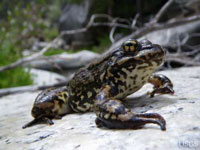U.S.G.S. biologists discover 19 new adult Rana muscosa frogs among 71 frogs and hundreds of tadpoles in a Mojave River pool of water.
U.S. Geological Survey field biologists Adam Backlin and Elizabeth Gallegos recently happened upon a pool of water along California's Mojave River teeming with Rana muscosa, the endangered mountain yellow legged frog that late last year suffered a setback when frogs in a breeding program died prior to release. Backlin and Gallegos were about 15 miles west of Wrightwood, California when they made the discovery of 71 adult frogs and hundreds of tadpoles in the pool of water, according to a report in the Los Angeles Times.

Photo by Adam Backlin, U.S.G.S
The mountain yellow-legged frog is listed as endangered.
Within three hours, the biologists netted 71 adult frogs, 52 of which were tagged and 19 which were new frogs. Exactly how these frogs are surviving the fungus is a mystery, Backlin told the Times. One theory is that after the fungus first swept through the San Gabriel mountains in the 1960s – wiping out up to 90 percent of the entire frog population – surviving frogs somehow developed an immunity, he said. Just two years ago, the same area in which Backlin and Gallegos netted the 71 frogs, it was estimated that five adult frogs lived.
The mountain yellow-legged frog, (Rana muscosa) once abundant throughout high altitude waterways of California has experienced a several decades steep decline in numbers due to such factors as pollution, pesticide poisoning, planted trout, and the deadly chytrid fungal disease that has wiped out amphibian populations worldwide. Just a year ago, a captive breeding program was dealt a setback when 104 animals set for release died unexpectedly.
The frog is around three inches in length and lives in high elevation lakes, ponds, streams, and pools of water in California. It hibernates in the winter months. The frog lays eggs in the spring and the tadpoles arrive approximately two months later and remain as tadpoles throughout the summer, winter, and following spring. They then start to metamorphose into frogs the following summer and fall. As adults, they can live 10-15 years.


